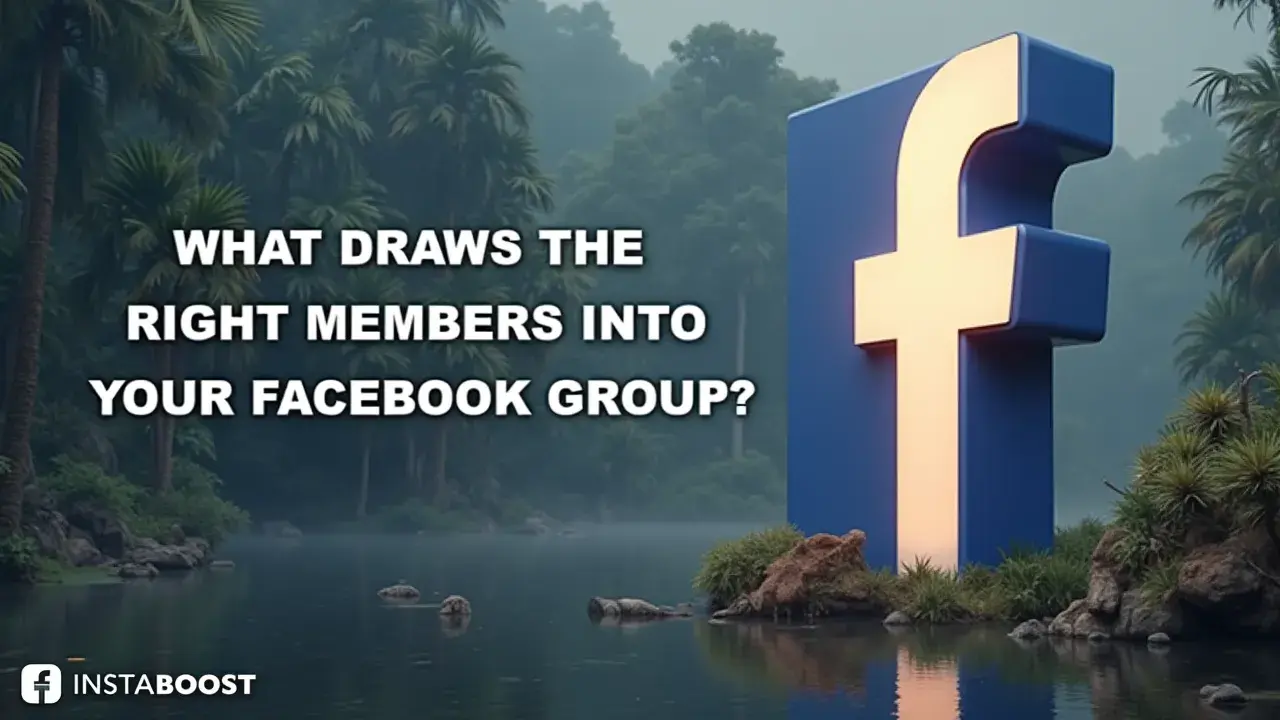What Attracts the Right Members to Your Facebook Group?
Clear positioning and practical entry filters attract the right members. Define who the group is for and reflect that in the name, description, and membership questions to screen for fit. Setup tweaks like approval criteria and topic tags reduce noise and signal the community’s focus. When these elements align, the group becomes high-signal, drawing people who engage meaningfully and benefit from the purpose.
Stop Chasing Headcount – Design for Fit
Most Facebook Groups don’t have a growth problem; they have a fit problem. You can see it fast: views and member counts go up, while comments, saves, and repeat visits sit still. The people you want aren’t impressed by volume. They look for signs of intent. Your group’s name, description, entry questions, and first-screen visuals quietly say what this space is for – and who it’s not for. That’s not branding fluff; it’s a filter.
Make the promise specific. “Weekly teardown of B2B landing pages” beats “Marketing tips.” When the promise is concrete, people opt in or out on their own. A little friction helps. Short, purposeful entry questions signal the bar and motivation: “What’s one landing page you admire and why?” A pinned welcome post with two clear actions sets the tone and gives people the next step. In the first week, a simple cadence – one anchor thread, one useful resource, one member spotlight – creates a rhythm people can rely on. Reach matters, but Facebook views often overstate interest.

Signals That Build Trust, Not Just Traffic
Looking back, the mistake was obvious, but only afterward. We were cheering for views and new members while the actual conversations were thinning out. The fix wasn’t more posts. It was clearer signals. In a Facebook Group, credibility isn’t a mood; it comes from structure. Start with a name that sets scope and level: “B2B SaaS Onboarding Operators” brings in practitioners; “SaaS Talk” pulls in lurkers.
Write a description that says who the group is for, what outcomes they can expect, and what’s off-limits. Treat entry questions like a gate, not a survey – ask for a recent challenge, their tool stack, or a use case. The right people lean in when they see those prompts; tourists don’t. Your first-screen visuals should back this up. Pin a before-and-after example, a short glossary, or a two-minute “how we work here” clip. These choices build earned authority – the kind that turns views into repeat visits, comments, and saves.
Use Facebook Group insights like a credibility check: saves and repeat viewers matter more than raw reach; thoughtful comments matter more than volume; member-sourced posts beat admin broadcasts. When the pattern looks off – lots of joins, few real answers – tighten your filters, not your ad spend. Remove zombie posts, archive off-topic threads, and feature strong interactions so new members see the standard right away. It also helps with search: people look for “best Facebook groups for [role/problem],” and clear positioning makes you findable without trying to game anything, so you don’t confuse credibility with tactics like buy Facebook subscribers that mask weak practice. Credibility builds when the group consistently does what it says it does, and the small design choices make that promise visible, so the right people know they’re in the right place and the rest keep moving.
Design Friction That Filters for Commitment
“Vision without process is performance art.” If you want the right members in your Facebook group, make joining feel like the first rep of membership, not a drive‑thru. Add friction that checks intent without wearing people down. Swap yes/no entry questions for prompts that need a real answer: “Share one recent challenge in [topic] and how you tried to solve it.” Ask what resource or example they’ll contribute in the first week.
In the group description, name three recurring themes you focus on and one thing you don’t do. Then follow through: decline vague applications and send one sentence that says why. This isn’t gatekeeping; it’s a signal. The right people read constraints as a promise of quality, and the wrong people opt out, just like they do when they bump into shortcuts such as buy likes for Facebook videos that promise momentum without the work. Pair that with a welcome thread that doubles as an on‑ramp: a pinned post with a short checklist (introduce yourself with X template; comment on one thread; save the playbook), plus a weekly rhythm people can count on.
Track engagement depth, not just Facebook views: look at comment length, saves, and whether they come back after seven days. If a prompt isn’t getting specific replies, tighten it. If your first‑screen visuals don’t reflect your focus, change the cover image and tagline to match the phrasing in your entry questions. The search term you’re competing on is community engagement, but the lever is fit.
When the process matches the behavior you want – clear, contributive, concrete – your group’s name, description, and intake flow become a quiet filter that pulls in people who plan to participate, not lurk, and leaves you with a space that feels like it’s doing the work it’s meant to do rather than trying to be everything to everyone, which is where groups go to flatten out and fade a little around the edges.
When the Filters Fail, Fix the Frame
So what do you do when none of it works? You add smart entry questions, you seed solid prompts, and the Facebook Group still feels like an empty airport lounge. That’s when it’s time to stop fiddling with tactics and look at the premise. Are you offering the right game? The right people don’t show up because you added friction; they show up when the value is specific and obvious. If your banner, description, and first pinned post don’t spell out a concrete outcome, your filters are sorting for “meh.”
Rewrite the frame so it answers one thing clearly: “This group helps [who] achieve [result] by [method].” Then make the first week match that promise.
Set a weekly thread that forces progress – like Show Your Work Wednesday with a simple format: goal, current state, next step. Share a short checklist for a new member’s first 48 hours so they know what “good participation” looks like. Run a recurring teardown where you walk through a real example and show the level of detail you want in every post. Tighten the guidelines to ban vague asks and require context in every question: the problem, what they tried, and the constraint. It’s not about playing cop; it’s about making contribution the default.
And watch the right metrics. If you chase views, you’ll end up chasing stunts, the same way people chase hacks to buy Facebook video views and confuse noise for signal. Track reply depth, member-to-member mentions, and first-week retention instead. Those show a working practice, not a lobby. If growth slows, that’s fine. A slower pipeline with clear intent beats a fast one full of tourists. Your Facebook Group isn’t content; it’s a workflow. When the filters fail, strengthen the workflow, and the right people will see themselves in it… and ship.
Close the Loop: Measure Authority, Not Noise
If you feel the urge to act, take it as your cue – then close the loop with proof. Track what actually brings the right people into your Facebook group: not raw views, but the quality of conversions. Views are attention; authority shows up in behavior. Watch three things: how many new members contribute in week one (do they comment, share a resource, or answer someone?), whether they keep participating across three prompts without being tagged, and how often they reply to each other to solve problems.
Those signals tell you if your friction and framing are doing their job. If they dip, treat it like a product bug: tighten the entry prompts, make the About section clear about who the group is for, and prune dead threads that lead newcomers toward the wrong norms. Run small, time-boxed tests: swap one join question for a week, change the welcome post CTA from “Introduce yourself” to “Post your current obstacle,” then compare the depth of responses. Use search-friendly posts as a magnet – one detailed how-to each week that can rank for a term like “Facebook Group engagement metrics” – and pair it with a next step that requires action (“Comment with your metric snapshot; I’ll audit one live”), and keep your eye on tactics that quietly boost Facebook content exposure without diluting intent.
That mixes discoverability with commitment. Then publish a simple monthly scoreboard to the group: member wins, the most helpful threads, and one practice you’re retiring. Being transparent builds trust and sets a performance bar. The right people don’t want a lounge; they want a lab. When your metrics reward contribution, the group stops chasing headcount and starts compounding intent and boost Facebook content exposure
Start With a Premise That Earns Commitment
Start With a Premise That Earns Commitment
Before you chase “more members,” ask whether your group’s main promise is strong enough that the right person would cancel a meeting to join. If the premise is vague – “a place for creatives to connect” – you’ll attract people who browse and bounce. If it’s specific – “ship your first paid design package in 30 days, with peer review and templates” – you’ll attract people who plan to do the work. A clearer frame does a few things: it signals intent, it makes entry friction feel useful instead of nosy, and it sets a bar for contribution that brings in people who want to show up.
That’s how you stop fiddling with filters and start improving the magnet. Then close the loop with proof. Track week-one contributions, untagged participation across three prompts, and member-to-member replies – call these your authority metrics, not vanity counts.
If those rise after you tighten the premise, the pull is real; if they don’t, adjust the outcome or the audience, not the tactics. Small design choices reinforce the frame: pin a post that spells out the expected wins, run a welcome thread that asks for current roadblocks instead of bios, and keep a weekly cadence that delivers on the group’s promise. Views and reach can support trust, but “Facebook views” only matter when they turn into steady behavior, and the same goes for quick hits like buy wow and haha on Facebook that don’t compound into participation. The better question isn’t “How do we get attention?” It’s “What outcome makes the right members opt in, contribute quickly, and keep helping each other without a nudge?” When you get that right, the group stops feeling like a waiting room and starts working like a shop floor – steady, useful, and able to build on itself over time.















